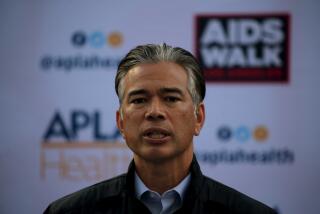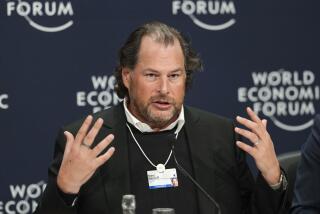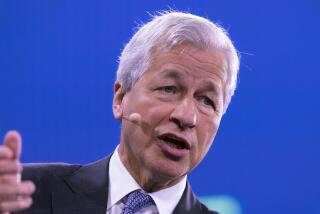Sale of FHP Corp. Stock by Officers Shows Workings of Insider Trading
Among serious stock watchers, insider trading is frequently considered a good indication of where a particular issue is headed. After all, who is in a better position to forecast a company’s near-term stock performance than its chairman or chief financial officer?
A good example is FHP Corp., a Fountain Valley health maintenance organization. Four insiders there recently sold a large chunk of stock at nearly $2 per share less than the general public paid when the company went public in July. In late November, the four key insiders, including Robert Gumbiner, FHP’s founder and chairman, sold as much stock as they could under legal limits imposed more than a year ago by state regulators when the company switched from nonprofit to profit-making status.
Although the term “insider trading” has taken on a negative meaning in the wake of the R. Foster Winans and Ivan Boesky scandals, such transactions generally are legal.
In FHP’s case, the November, 1985, agreement under which the state Department of Corporations permitted FHP’s insiders to convert to a for-profit HMO from a nonprofit entity, forbade Gumbiner and the others from selling the bulk of their stock for at least two years.
Some Sales Permitted
However, the agreement did permit them to dispose of up to 5% of their individual holdings after Nov. 25, 1986, said William Kenefick, senior counsel for the Department of Corporations,
And that’s exactly what they did.
On Nov. 26, the first day it became legal for them to do so, Gumbiner and his son, along with Wescott Price III and David LeSueur, both FHP vice presidents, sold a total of 321,250 shares at $10.50 each in a series of private transactions valued at nearly $3.4 million. Except for Burke Gumbiner--the chairman’s son and corporate treasurer--each insider sold exactly 5% of his stake in FHP. Burke Gumbiner sold slightly less than 3% of his shares.
“They certainly didn’t waste any time in selling it,” remarked Dorothy Ryan, a health-care analyst with the San Francisco office of Swergold Chefitz & Sinsabaugh Inc., an investment banking firm.
Like other analysts, Ryan said there could be several reasons for the sales--which were reported to the Securities and Exchange Commission as required by law. Those reasons, she said, could include the changes in the way capital gains will be treated under the new tax law that took effect this year.
Shares Fell
FHP went public in July at $12 a share and immediately fell 50 cents a share to end its first day of trading at $11.50. After bottoming out at $7.75 a share in September, FHP rebounded to the $10.50-a-share range, where it has lingered since the November insider sales.
Kenefick said the Department of Corporations allowed the sale of up to 5% of the insiders’ stock to help them raise funds to pay capital gains taxes arising from the public offering.
Still, to conclude that the insiders sold--at least in part--because they think the stock is fully priced at $10.50 per share is “not an unreasonable assumption,” said Larry Selwitz, an analyst with Bateman Eichler, Hill Richards Inc., a Los Angeles investment firm. Most HMO stocks, he said, have been poor performers lately.
Although he acknowledges that 5% was all the insiders could have legally sold, FHP spokesman Stuart Byer said he believes the stock is undervalued. “If they sold 50% of their stock you could make a case for them thinking the stock had topped out,” Byer said.
Jerry Treppel, who follows FHP for Merrill Lynch, Pierce, Fenner & Smith--the lead underwriter in FHP’s initial offering last year--agrees, saying that the insider sales don’t carry a bearish message for investors. The company, he said, appears strong on an operating basis.
During the fiscal year that ended last June 30, FHP’s net earnings increased 24% to $9.1 million. Based on the current 12.5 million shares outstanding, Treppel’s estimates for FHP’s current fiscal year place net income at $12.5 million to $13.7 million.
“I think the stock price has been weak because of investor nervousness over the HMO group in general,” said Treppel, who added that a lawsuit filed against Gumbiner and two other insiders by the California attorney general’s office may also account for some of the stock’s weakness.
Made Handsome Profit
The suit, filed in 1985 as FHP was preparing to convert to a money-making enterprise from a nonprofit, charitable corporation, alleges that the $38.5 million that FHP’s managers gave to charity in exchange for ownership of the company wasn’t enough. An amendment to the suit filed last month seeks at least $80 million more for charity.
Whatever the reason for the insiders’ November stock sale, one thing is certain: They made a handsome profit at the same time that public shareholders were watching their initial investment decline.
The public investors who paid $12 a share, or a total of $36 million for their 23.9% of FHP, had taken a 12.5% loss at the Nov. 26 price of $10.50 a share and since have seen the stock fall an additional 25 cents a share for a net loss of 14.6%.
More to Read
Inside the business of entertainment
The Wide Shot brings you news, analysis and insights on everything from streaming wars to production — and what it all means for the future.
You may occasionally receive promotional content from the Los Angeles Times.










